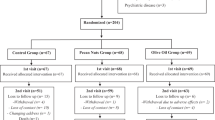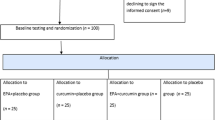Abstract
The objective of this study was to investigate whether a diet rich in legumes are associated with oxidative stress among type 2 diabetic patients. In a randomized, controlled, crossover clinical trial, 31 type 2 diabetic patients were randomly assigned to receive 2 diets, each for a period of 8 weeks: (1) The legume-free therapeutic lifestyle change (TLC) diet and (2) the legume-based TLC diet. Both diets were similar except that 2 servings of red meat were replaced by different types of legumes 3 days per week in the legume-based TLC diet. Oxidative stress biomarkers were measured at baseline and after 8 weeks. Compared to the legume-free TLC diet, the legume-based TLC diet significantly decreased malondialdehyde (−0.22 versus −0.68 μmol/l; P=0.002), oxidized-LDL (−0.9 versus −2.3 mU/l; P=0.05) and increased nitric oxide (0.40 versus 0.96 mM/l; P=0.03) and catalase activity (1.2 versus 2.1 Iu/ml; P=0.05).
This is a preview of subscription content, access via your institution
Access options
Subscribe to this journal
Receive 12 print issues and online access
$259.00 per year
only $21.58 per issue
Buy this article
- Purchase on Springer Link
- Instant access to full article PDF
Prices may be subject to local taxes which are calculated during checkout
Similar content being viewed by others
References
Ceriello A . New insights on oxidative stress and diabetic complications may lead to a 'causal' antioxidant therapy. Diabet Care 2003; 26: 1589–1596.
Xu B, Chang SK . Comparative study on antiproliferation properties and cellular antioxidant activities of commonly consumed food legumes against nine human cancer cell lines. Food Chem 2012; 134: 1287–1296.
Hu Y, Block G, Norkus EP, Morrow JD, Dietrich M, Hudes M . Relations of glycemic index and glycemic load with plasma oxidative stress markers. Am J Clin Nutr 2006; 84: 70–76.
Martin H, Uring-Lambert B, Adrian M . Effects of long-term dietary intake of magnesium on oxidative stress, apoptosis and ageing in rat liver. Magnes Res 2008; 21: 124–130.
Crujeiras AB, Parra D, Abete I, Martínez JA . A hypocaloric diet enriched in legumes specifically mitigates lipid peroxidation in obese subjects. Free Radic Res 2007; 4: 498–506.
Jang Y, Lee JH, Kim OY, Park HY, Lee SY . Consumption of whole grain and legume powder reduces insulin demand, lipid peroxidation, and plasma homocysteine concentrations in patients with coronary artery disease: randomized controlled clinical trial. Arterioscler Thromb Vasc Biol 2001; 21: 2065–2071.
Rotimi SO, Olayiwola I, Ademuyiwa O, Adamson I . Inability of legumes to reverse diabetic-induced nephropathy in rats despite improvement in blood glucose and antioxidant status. J Med Food 2010; 13: 163–169.
Hosseinpour-Niazi S, Mirmiran P, Hedayati M, Azizi F . Substitution of red meat with legumes in the therapeutic lifestyle change diet based on dietary advice improves cardiometabolic risk factors in overweight type 2 diabetes patients: a cross-over randomized clinical trial. Eur J Clin Nutr 2015; 69: 592–597.
Raymond JL, Couch SC . Medical nutrition therapy for cardiovascular disease Mahan LK, Escott-Stump, Raymond JL Krause’s Food and the Nutrition Care Process. National Academies Press: National Academies Press, 2012; 753.
Thampi BS, Manoj G, Leelamma S, Menon VP . Dietary fiber and lipid peroxidation: effect of dietary fiber on levels of lipids and lipid peroxides in high fat diet. Indian J Exp Biol 1991; 29: 563–567.
Acknowledgements
The authors would like to thank the participants who participated in the present study. The authors wish to express their appreciation to Ms N Shiva for critical editing of English grammar and syntax of the manuscript. This work was supported by the Research Institute for Endocrine Sciences, Shahid Beheshti University of Medical Sciences, Tehran, Iran (grant 411). This work was supported by the Research Institute for Endocrine Sciences, Shahid Beheshti University of Medical Sciences, Tehran, Iran (grant 411). The project idea for this study was from SH-N and PM. The project was designed by PM, SH-N and FA; SHN analyzed and interpreted the data; SHN and PM prepared the manuscript. All authors have read and approved the final manuscript. Overall FA supervised the project and approved the final version of the manuscript to be submitted.
Author information
Authors and Affiliations
Corresponding author
Ethics declarations
Competing interests
The authors declare no conflict of interest.
Rights and permissions
About this article
Cite this article
Mirmiran, P., Hosseinpour-Niazi, S. & Azizi, F. Therapeutic lifestyle change diet enriched in legumes reduces oxidative stress in overweight type 2 diabetic patients: a crossover randomised clinical trial. Eur J Clin Nutr 72, 174–176 (2018). https://doi.org/10.1038/ejcn.2017.113
Received:
Revised:
Accepted:
Published:
Issue Date:
DOI: https://doi.org/10.1038/ejcn.2017.113



